Inquivix HQ
1-903, 18 Eonju-ro 146-gil,
Gangnam-gu, Seoul, Korea
06057
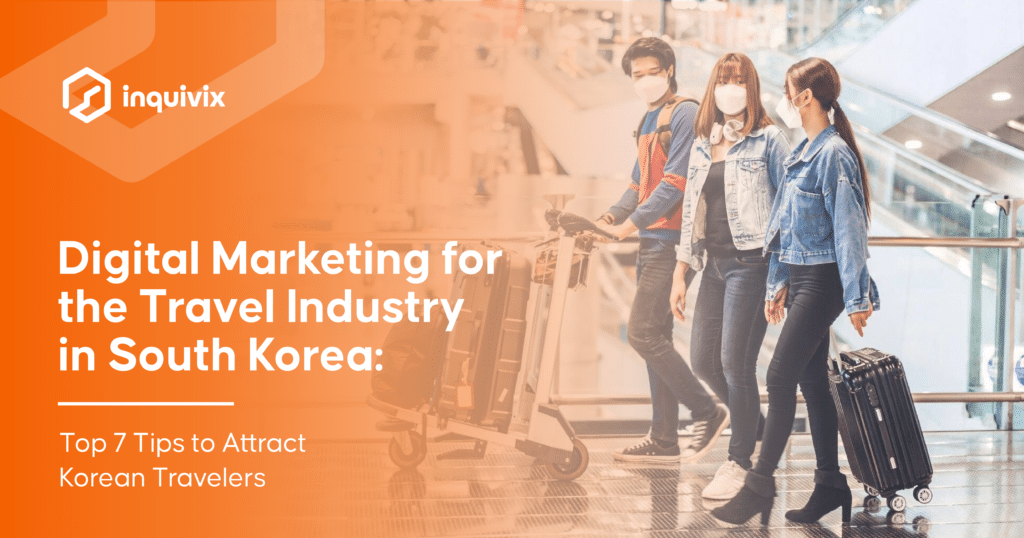
Are you in the travel industry looking for business opportunities in South Korea? Then this post is for you.
In today’s world, the travel & tourism industry has risen as a major contributor to the global economy. People engage in traveling for various reasons from leisure to work. For businesses in the travel industry, South Korea offers many opportunities for successful business. With a high disposable income, many South Koreans travel to holiday destinations as well as for education and work purposes. Strategic digital marketing can help you attract these potential customers to your business increasing the chance of conversion.
In this article, we are exploring the travel industry in South Korea and digital marketing for the travel industry with the best strategies to use when entering the South Korean travel world. Let us get started!
What Exactly Is the Travel Industry?

The travel industry is a vast global marketplace with millions of people engaging in traveling each day, spending billions of money. With many players, the travel industry has become a highly competitive stage for new businesses planning to enter this sector. Since the industry is highly competitive, businesses must continually adapt to changing trends and consumer preferences to remain relevant and profitable. The ultimate goal of the travel industry is to serve travelers with excellent service and make their traveling experience smooth.
There are many types of sectors and companies operating within the travel industry. Among other things, it includes transportation services, accommodation providers, food & beverages, tour operators, and others. The main objective of the industry is to give travelers pleasurable experiences while also making a profit for the companies involved. Let’s take a brief look at some of the sectors and businesses in the travel industry.
Let’s Look into the Travel Industry in South Korea
As one of Asia’s fastest-growing economies, South Korea represents a fascinating fusion of traditional heritage and state-of-the-art modernity. This dynamism also extends to its travel industry, a sector that expresses a diverse range of motivations and preferences among South Koreans. With their increasing wealth and their desire to explore the world, South Koreans are shaping the landscape of the country’s travel industry with diverse needs and demands.
Why Do South Koreans Travel?
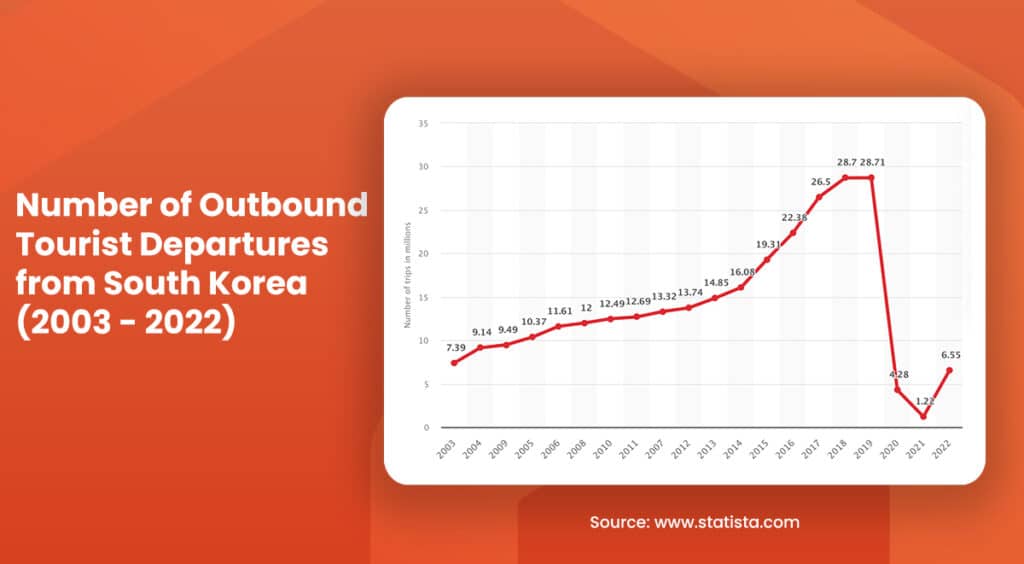
South Korean travelers are driven by various motivations that push the boundaries of traditional vacationing. Seeking out novel experiences, they are drawn to overseas holiday destinations that offer a mix of cultural novelty, picturesque settings, and innovative adventures. From the upbeat city life in Europe and America to the serene landscapes in neighboring Asian countries, they yearn for experiences that transcend their daily routines.
More than mere leisure, many South Koreans also travel for business and educational purposes. South Korea’s booming economy necessitates a substantial amount of business travel, and many South Koreans combine these requirements with leisure activities. Similarly, educational travel, from language immersion programs to cultural exchanges, often serves as a stepping stone for personal growth and global competitiveness. Adventure and relaxation also walk hand in hand in the form of outdoor activities, group package tours, family vacation packages, cultural and nature tours, alongside the increasingly popular culinary tours that offer an exploration of global cuisines.
Analyzing the South Korean Traveler’s Profile
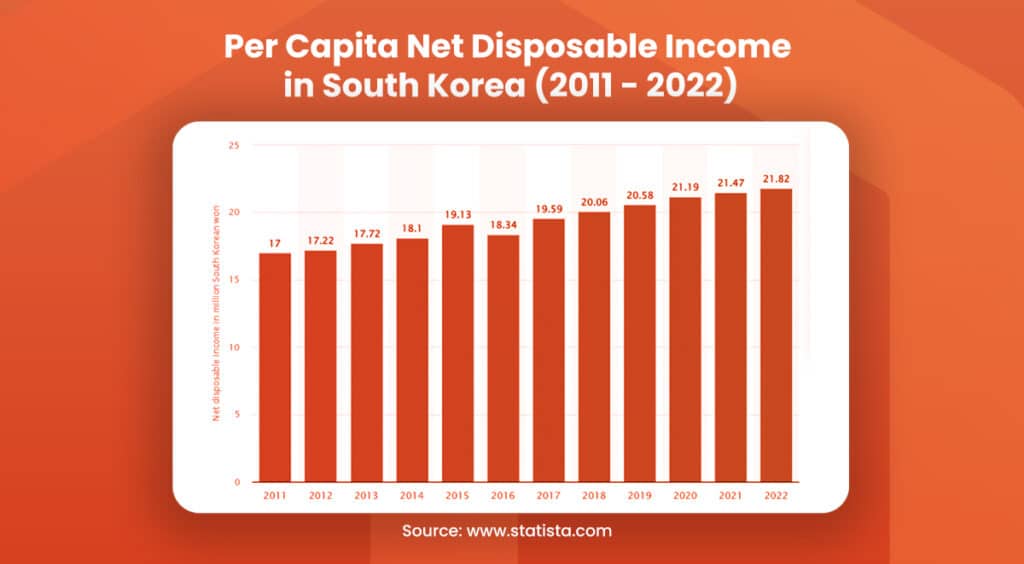
With South Korea’s per capita disposable income amounting to around 21.82 million South Korean won in 2022, up from about 21.47 million South Korean won in the previous year, there’s been a steady rise in the purchasing power of Koreans. This financial boost has made traveling more accessible and frequent, giving rise to an ever-expanding outbound travel industry.
An analysis of South Korea’s outbound tourist departures in 2022 shows a demographic tilt towards the age group 20 to 60 years. Specifically, the 31-40 years age bracket leads with 1,361,680 travelers, followed by the 21-30 years age group with 1,201,870 travelers. The 41-50 years and 51-60 years age groups are not far behind, with 1,116,860 and 920,740 travelers respectively. This broad range of age groups indicates the universal appeal of travel among South Koreans and can serve as a key insight for marketers to target their services effectively.
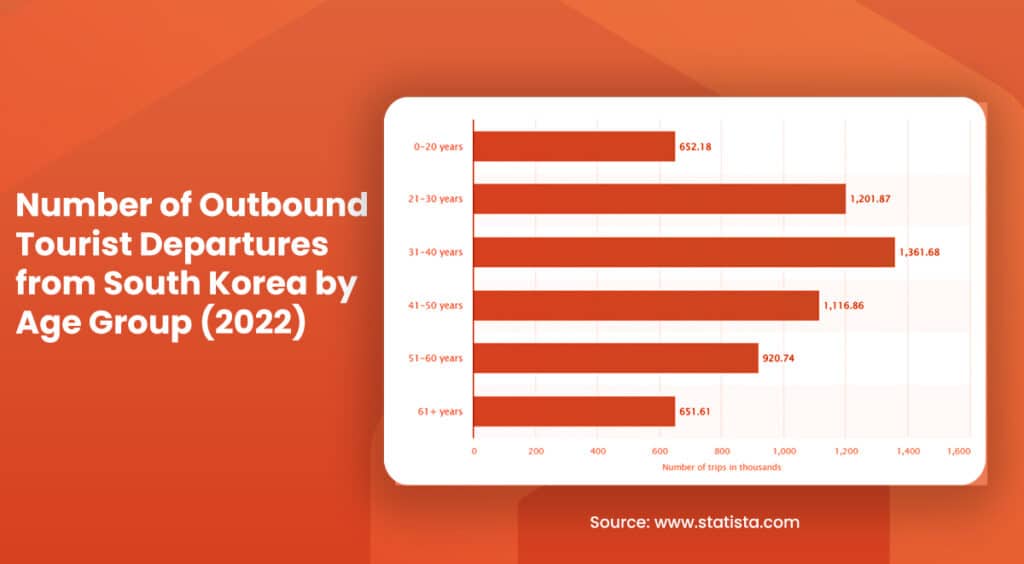
Digital Transformation of the Korean Travel Industry
South Korea is one of the most dynamic and digitally advanced countries in the world, where the adaptation of digital technology has been embraced wholeheartedly, dramatically changing the landscape of its travel industry. Korean consumers have adapted to this digital revolution, shifting from traditional travel planning methods to digital platforms for making arrangements and bookings. The ease of comparing deals, reading reviews, and making instant bookings has redefined the travel planning process, turning it into an efficient and flexible experience.
The popularity of social networking has played a significant role in this transformation. Travelers sharing their experiences, reviews, and recommendations through digital media has become a key factor in influencing the choices of their peers. Online platforms have become the go-to source for planning itineraries, making reservations for activities, and booking hotels and flights.
This shift towards digital channels has also changed the way payments are processed. Traditional modes of payment have been largely replaced by digital payments that offer quick, secure, and convenient transactions. The Korean consumer can now instantly pay for their bookings using online banking, credit cards, and even digital wallets, or apps like Naver Pay or Kakao Pay contributing to a significantly improved customer experience.
Why Is Digital Transformation Significant in the Tourism Industry?
Korea is a unique market in terms of digital adaptation, with digital marketing playing a significant role in shaping consumer behavior. Businesses are using digital platforms to increase their online visibility, reach new audiences, and stay competitive. Digital marketing in South Korea is highly advanced, with businesses effectively utilizing search engine optimization (SEO), content marketing, and social media engagement to reach their target audience.
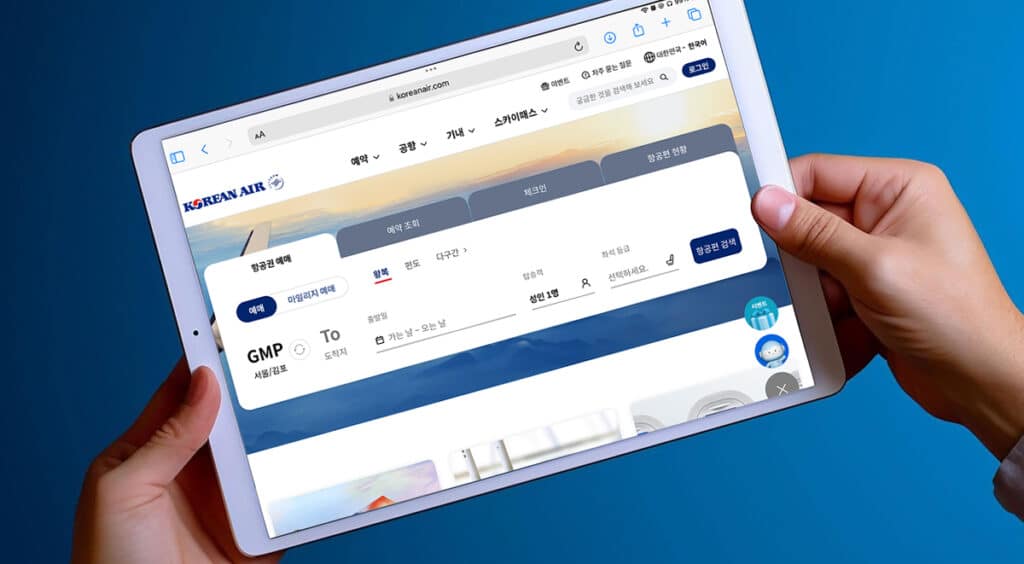
Digital transformation in the tourism industry, particularly in South Korea’s dynamic landscape, bears tremendous influence and holds significant importance. Streamlining operations and fostering innovation through digital transformation contributes to a great impact on the sector’s growth, shaping a future that caters to the digital-savvy traveler. One of the most beneficial impacts of digitization is cost reduction. Through automated booking systems and efficient digital marketing platforms, the need for labor-intensive processes diminishes, and reaching consumers becomes a more cost-effective endeavor.
Furthermore, digital transformation plays a pivotal role in enhancing brand visibility. In today’s travel industry, a strong online presence is indispensable. Businesses can effectively tap into the global audience using strategies such as SEO, and social media engagement, thereby transcending geographical boundaries. Also, it is worth noting that digital adaptation is vital for competitiveness. To stay relevant, businesses must keep pace with digital trends and societal needs, ensuring that they provide a smooth digital experience throughout the customer journey. As South Korean consumers increasingly expect such experiences, companies that meet these expectations will not only retain their existing clientele but also attract new customers. Ultimately, digital transformation is not an option but a necessity for survival and prosperity in the tourism industry. Those who embrace this transformation are likely to thrive, while those who resist may fall behind in this fast-paced digital race.
Top 7 Digital Marketing Strategies to Enter the South Korean Travel Industry
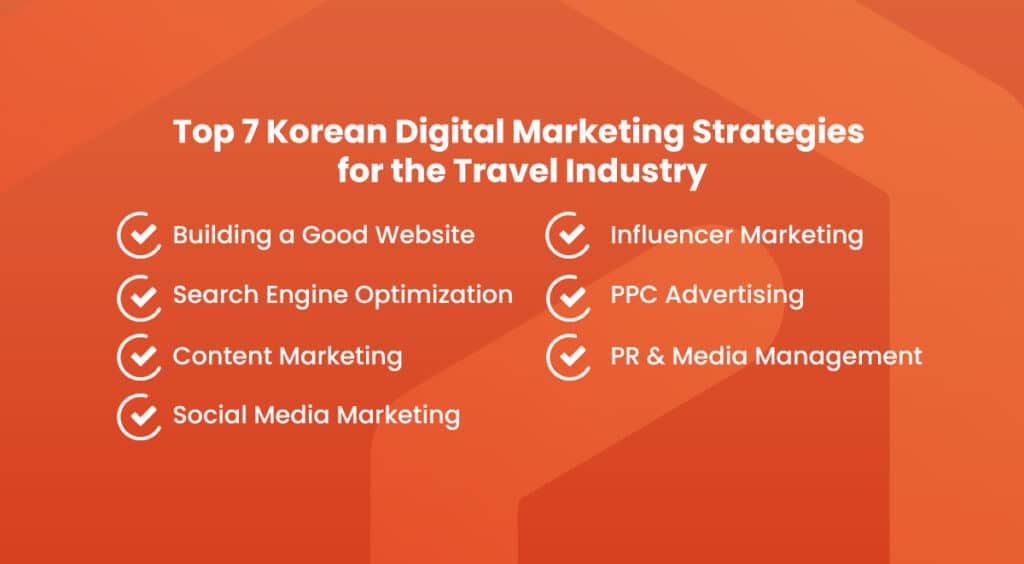
As we delve into an increasingly digital age, breaking into South Korea’s travel industry requires a comprehensive digital marketing strategy. Well-known for its technological advancement and high internet penetration, the South Korean market presents great opportunities for the travel industry. To effectively engage with digitally-savvy Korean consumers, businesses must leverage a blend of digital marketing strategies – from building a responsive website and optimizing for local search engines to leveraging content marketing and social media channels, from harnessing the power of influencers to managing online reputation. Here, we explore the top digital marketing tactics for making a mark in the South Korean travel industry.
#1 Building a Good Website
A website is the digital face of your business and it is the major point of interaction with your potential customers. A website containing information about your business, product, or service as well as other important details will move the potential clients to take your desired action. A high-quality, optimized, and user-friendly website will help your business immensely. Also, the website should be available in Korean since they prefer to use their mother tongue for communication. Another factor is the mobile responsiveness of your website. Especially for tech-savvy South Koreans, where the majority use smartphones, having a responsive website with quick load times and easy navigation is vital. Your website should work seamlessly across multiple devices, ensuring that it provides an excellent user experience, whether your customers are browsing or making purchases.
#2 Search Engine Optimization
Search engine optimization (SEO) is essential to increase your brand’s online visibility. In the South Korean market, you should focus on using SEO strategies that target popular local search engines. Tailoring your content with keywords relevant to Korean audiences can significantly improve your ranking, and drive organic traffic to your website. Also, strong SEO can increase your authority and credibility online.
Let us take a brief look at the key search engines in South Korea and how you can use SEO on these platforms.
Naver
Naver is the most popular search engine in South Korea with over 50% of the market share. Optimize your content based on Naver’s search algorithm, and use Naver strategies like Naver Cafes, and Naver Blogs to improve your visibility.
While Naver dominates the market, Google also has a significant presence. Ensure your content is also optimized for Google’s SEO requirements.
[Daum
Daum is another popular search engine in South Korea. Similar to Naver, you can leverage Daum’s unique platforms such as Daum Cafe and Daum Blog for better visibility.
#3 Content Marketing
In South Korea, content marketing extends beyond traditional blogging. Leveraging platforms like Naver Blog, collaborating with Naver Blog Influencers, and creating engaging video content for platforms like YouTube can help you reach and engage a broader audience. A Naver Brand Blog can increase your business visibility by providing information, tips, and other content to your target audience ultimately leading them down the sales funnel. At the same time, partnering with Naver Blog Influencers can increase your credibility and the chance of attracting more potential customers.
#4 Social Media Marketing
With a more than 95% internet penetration rate in the country, Social media can help tourism companies willing to enter South Korea to attract customers, get customer feedback, and build customer loyalty within a short time as a part of their travel marketing strategy. Having a solid social media presence is crucial in the South Korean market.
Regular engagement on platforms like Instagram, KakaoTalk, Naver Cafe, and Facebook can strengthen your relationship with the audience. Posting regular updates, promotions, and interactive content can enhance your brand’s visibility and credibility. Social media easily increases sales revenue by building customer networks and advertising in the various stages which ultimately results in developing the brand.
#5 Influencer Marketing
Influencers hold significant sway in South Korea’s social media landscape. Collaborating with influencers in the travel industry can increase brand visibility and engender trust among potential customers, as personal experiences and recommendations carry considerable weight.
#6 PPC Advertising
Pay-per-click (PPC) advertising is an effective way to target specific audience segments. Using popular ad platforms like Naver Ads, Kakao Ads, Google Ads, and display networks like Taboola can help you reach your target audience effectively and promptly. This strategy is highly effective as most of these platforms offer advanced targeting options to help you reach your desired audiences.
#7 PR and Media Management
Maintaining a positive online image is crucial in South Korea, where online reviews and ratings heavily influence consumer decisions. Regular monitoring of customer feedback and promptly addressing any negative reviews or complaints can help maintain and improve your brand’s reputation.
Navigating the Digital Wave: Charting Success in South Korea’s Travel Industry

In conclusion, the digital landscape of South Korea presents a wealth of opportunities for businesses in the travel industry. Understanding the country’s unique digital ecosystem, from the popularity of local search engines and social platforms to a propensity for mobile usage and the impact of influencers, is crucial to developing effective marketing strategies. As we navigate the digital wave, it’s clear that businesses must adapt and innovate continuously, meeting the evolving expectations of Korean travelers and leveraging digital transformation’s immense potential. By doing so, they can tap into South Korea’s dynamic travel industry, engage the country’s tech-savvy consumers, and chart a successful path in this vibrant market.
If you are in the travel industry and looking for a way to attract the South Korean market, you need the help of an experienced digital marketing agency. And that is where Inquivix comes in. We are based in South Korea with years of experience in digital marketing and expertise in the Korean market. Check out our blog for more information on South Korea and contact us for a free consultation.
FAQs
Social media stands out as one of the most potent marketing mediums for the tourism sector. The key lies in selecting the appropriate platform (where your target audience frequents) and devising a tailored strategy for each platform.
The USA is a favorite, with approximately 800,900 visitors from South Korea in 2022. Vietnam follows with 567,700 visitors. Japan also draws a significant number, with 556,500 visitors.
